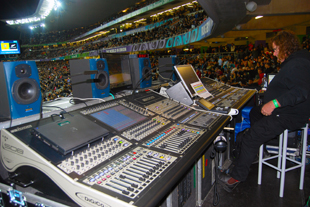Commanding the attention of 20 nations and millions of viewers, the 2011 Rugby World Cup was broadcast in numerous formats, across several media and in countless countries – its requirement for world-class A/V was inescapable.
 No stranger to high-profile events, Scott Willsallen (Principal of Sydney based Technical Production Consultancy Auditoria) was called in by David Atkins Enterprises (DAE) to handle audio design for the competition. Oceania was the audio supplier working under the direction of Scott Wilsallen and DAE for the project.
No stranger to high-profile events, Scott Willsallen (Principal of Sydney based Technical Production Consultancy Auditoria) was called in by David Atkins Enterprises (DAE) to handle audio design for the competition. Oceania was the audio supplier working under the direction of Scott Wilsallen and DAE for the project.
‘There were many factors in choosing DiGiCo,’ Willsallen says of the mixing desks used: ‘Along with Madi interconnectivity, channel count, sound quality and reliability we had a direct line to DiGiCo and Group Technologies for support. Ever since the release of the SD series with the SD7, the expanding range of consoles are industry-leading in every aspect. I have had excellent experience with the SD range of consoles, both on fixed installations and on annual event projects, most of which I have re-designed to suit greater use of DiGiCo consoles.’
Auditoria has had a long history in handling audio for the Rugby World Cup, and the choice to go with DiGiCo has become more apparent as the project requirements increase each year: ‘For major events such as this, I have used alternative consoles from other manufacturers which have served me very well over the years. However, as the requirements for these projects continue to grow and the rehearsal time reduces; coupled with my constant desire to improve the quality of the audience experience, the advantages of DiGiCo’s SD range are very clear.’
Two consoles were used in a mirrored set-up: ‘Two SD8 surfaces were used in a dual redundant configuration,’ Willsallen confirms. ‘The primary SD8 was connected to the Optocore network via Madi through an Optocore DD4ME, and the secondary SD8 was connected to the analogue network via standard DiGiCo DiGiRacks. The amplifiers receive an AES signal from the Optocore network and an analogue signal from the analogue network. All switching between primary and secondary signal paths was done in the amplifiers.
‘Each of the two SD8s were performing both FOH and monitor mixing duties and we were using every available input and output to make it work on a single console. The systems performed flawlessly and I have designed DiGiCo consoles into another major event project later this year in Doha where the two SD8s will be used for FOH mixing in a dual redundant configuration and a single SD7 will be used for monitors using the dual engines for redundancy.’
See also:
Surround broadcast for the 2011 Rugby World Cup
More: www.grouptechnologies.com.au
More: www.digico.org
More: www.optocore.com














